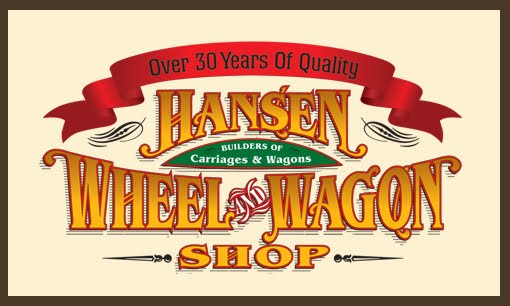
Studebaker “Sprinkler” wagons were used to water down the dust on the roads. The sizes of Studebaker sprinklers ranged from 175 gallons to 1000 gallons. This particular wagon has a 650 gallon tank. Sprinkler wagons were fitted with a 5th wheel running gear that balanced the tank and allowed 90 degree turns. Doug Hansen tested out this wagon and you can watch the video on YouTube.
 The Booby-Hut is a unique sleigh design that is a carriage body put upon sleigh runners. The body is suspended with leather braces similar to a stagecoach suspension. There are very few originals of this vehicle left in existence. It is a privilege to be able to restore one in such great condition. At the back of the body you can see what is called the “sword-case”, accessible from the inside of the body. These sword-cases were used to carry arms in the old highway robbery times. This vehicle’s design is very light, strong and elastic. We are anxious to see this unique sleigh in its original colors, it was painted black body with emerald green lower pales, yellow striping and an emerald green gear, this complimented the green plush interior trimming. Check this blog for further updates of this project.
The Booby-Hut is a unique sleigh design that is a carriage body put upon sleigh runners. The body is suspended with leather braces similar to a stagecoach suspension. There are very few originals of this vehicle left in existence. It is a privilege to be able to restore one in such great condition. At the back of the body you can see what is called the “sword-case”, accessible from the inside of the body. These sword-cases were used to carry arms in the old highway robbery times. This vehicle’s design is very light, strong and elastic. We are anxious to see this unique sleigh in its original colors, it was painted black body with emerald green lower pales, yellow striping and an emerald green gear, this complimented the green plush interior trimming. Check this blog for further updates of this project. This is a restored Army Escort Wagon. All original hardware was reused but all wood components had to be replaced. This wagon supplied provisions for the troops, anything from food to ammunition to shelter. The unique characteristics are winged flair boards a double tiered jockey box / tool box / foot board, an ax carrier within the wagon, and a shovel carrier under driver seat. Also these wagons had rough lock chains, a tail gate with a chain retainer to offer rear platform. The wheels are heavy duty being 54" high and 3" wide. This wagon is going to be an interactive outdoor display at the Mormon Battalion Museum in San Diego, CA.
This is a restored Army Escort Wagon. All original hardware was reused but all wood components had to be replaced. This wagon supplied provisions for the troops, anything from food to ammunition to shelter. The unique characteristics are winged flair boards a double tiered jockey box / tool box / foot board, an ax carrier within the wagon, and a shovel carrier under driver seat. Also these wagons had rough lock chains, a tail gate with a chain retainer to offer rear platform. The wheels are heavy duty being 54" high and 3" wide. This wagon is going to be an interactive outdoor display at the Mormon Battalion Museum in San Diego, CA. You may remember this coach from the last blog post, where it was under construction. The antique patina finish our craftsmen applied to this stagecoach gives it a rich historic look. This coach was recently on display in at the South Point Casino in Las Vegas for the Wrangler National Finals Rodeo. It’s new home is in Glendora, CA where it will be on private display.
You may remember this coach from the last blog post, where it was under construction. The antique patina finish our craftsmen applied to this stagecoach gives it a rich historic look. This coach was recently on display in at the South Point Casino in Las Vegas for the Wrangler National Finals Rodeo. It’s new home is in Glendora, CA where it will be on private display. The concord buggy was invented in Concord N.H. in about 1813 by Lewis Downing. In 1828 Downing was joined in business by Joseph Stephens Abbot. Their heavy Abbot-Downing coaches became famous, being used by companies such as Wells Fargo. The Concord buggy was an inexpensive, stylish and multipurpose substitute for the pricey and burdensome English carriages of the time. Lightly constructed of strong and flexible timbers such as hickory, the buggy was well suited to rough roads. It was fitted with a top and a dashboard to protect the driver and passenger from dust and mud. This vehicle became typical in the West, and this particular wagon hand crafted by Hansen Wheel and Wagon Shop resides at Wagon Hound Ranch in Wyoming.
The concord buggy was invented in Concord N.H. in about 1813 by Lewis Downing. In 1828 Downing was joined in business by Joseph Stephens Abbot. Their heavy Abbot-Downing coaches became famous, being used by companies such as Wells Fargo. The Concord buggy was an inexpensive, stylish and multipurpose substitute for the pricey and burdensome English carriages of the time. Lightly constructed of strong and flexible timbers such as hickory, the buggy was well suited to rough roads. It was fitted with a top and a dashboard to protect the driver and passenger from dust and mud. This vehicle became typical in the West, and this particular wagon hand crafted by Hansen Wheel and Wagon Shop resides at Wagon Hound Ranch in Wyoming.




















